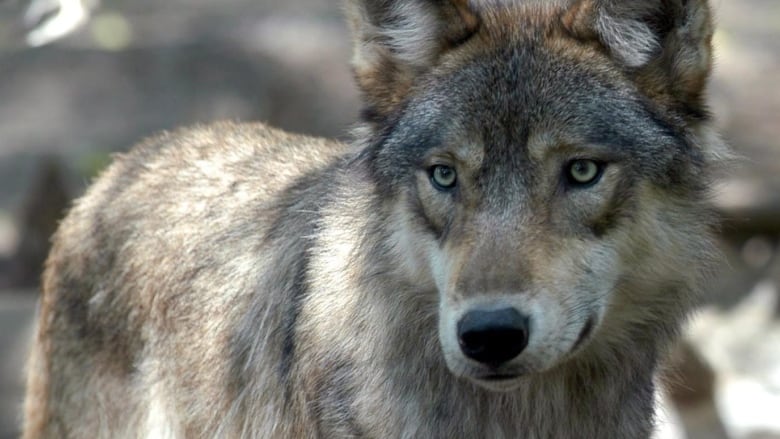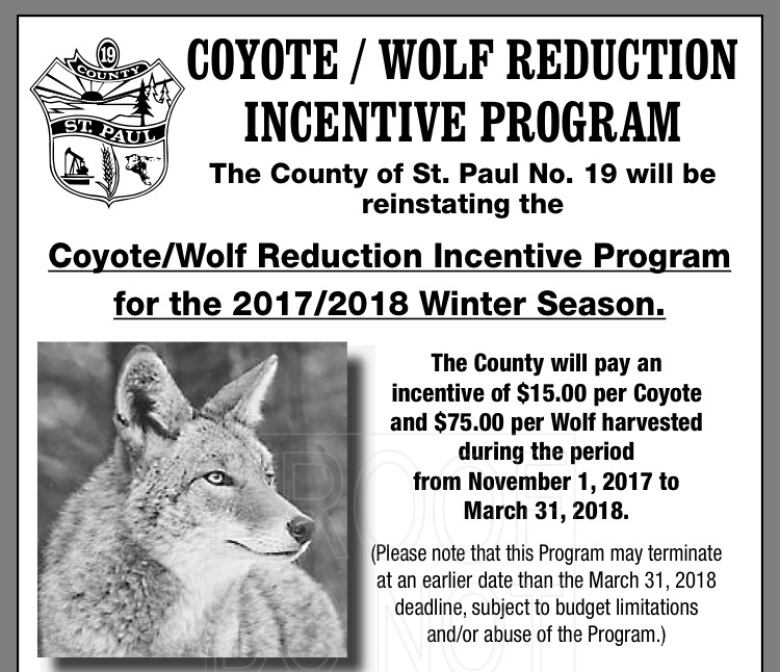Cree councillor, wildlife biologist object to Alberta wolf and coyote culls
'I wouldn't shoot a coyote unless it was attacking,' says Saddle Lake elder

A councillor from Kehewin Cree Nation in northern Alberta says he objects to acoyote and wolf reduction incentive program advertised bythe local county, as an attack on the "four legged nation."
There are 16 municipalities with predator bounty programs in Alberta.St. Paul county introduced its program six years ago in order to reduce the population of coyotes and wolves over the calving season.
The bounty offers a payout of $15 per coyote and $75 per wolf to a maximum number of 20 coyotes/wolves per week, and a total season maximum of 100 coyotes/wolves per resident/landowner.
KehewinCree Nation councillor Benjamin Badger saidthe "four-legged nation," which includes the wolf and coyote family clans,have shared the land with Indigenous people foreverand should not be hunted and killed.
"The farming and agriculture has just devastated the land that they use to sustain themselves," said Badger.
"Metaphorically, you take what's happening to the wolves and apply it to whatIndian people had to face ... there's so much correlation."
'It's not right'
He referenced the Canadian government's policy to "get rid of the the Indian problem" in the late 1800s and early 1900s, which was unsuccessful, but still produced harmful results such as intergenerational trauma stemming from Indian residential schools.

"The wolves are starting to reclaim the land that was already theirs," said Badger.
"The wolves are encroaching on municipal jurisdictions but those are fictional borders, you can't see them. The animals don't see that."
Saddle Lake Cree Nation elder and hunter Joe Cardinal said he's noticed the St. Paul area filling with more predatory animals in recent years.
He said he doesn't agree with the large culling of wolves and coyotes, but added that county wildlife officials should make sure the reduction program is carried out in the least harmful way.
"I respect all animals," said Cardinal.
"I don't take nothing [from the land]unless it has to be taken for food purposes. I wouldn't shoot a coyote unless it was attacking. It's not right."
Non-targeted species affected
Wildlife biologist Gilbert Proulx has studied predation bounty programs in the Prairies since they were reintroduced in Alberta and Saskatchewan in 2007 and 2009 after 40 years.
He saidthe reduction tactics are inhumane and ineffective.
"The scientific community, environmental organizations and public must vigorously condemn the use of such programs," said Proulx.
According to Proulx, killing methods used by bounty hunters includeshooting animals in non-vital regions of their bodies, neck snares and strychnine poisoning, which causes suffering and delayed deaths. It also causes unnecessary deaths to many non-targeted species.
"There is no proof to demonstrate that wolves or coyotes prey on livestock," he said.
"I find it frustrating that a small interest group can dictate the future of our wildlife communities."
'A political decision'
He said he's spoken with ranchers from the area who have told him they don't have a problem with coyotes or wolves.
He called the bounty "a political decision" aimed at appeasing farmers and rancherswho have lost livestock, but said they already receive compensation from the government for their losses.
Killing off predators won't solve concerns ranchers may have regarding predators stalking their livestock, he said.
"Wolves are dominant animals," he said.
"If you kill a dominant animal and destroy the social structure, the ones that survive, suddenly they're the new bosses. They split and each make their own pack, and then there's coyotes and wolves from other regions that come in."
Proulx co-authored a study that reportedthatfrom2010 to 2015,25,940 coyotes and 1,425 wolves were killed in Alberta through bounty programs.
County rules
Keith Kornelsen, agricultural fieldman for St. Paul county, said the county has averaged a yearly payout of $18,000 in its bounty program. Itbudgets $25,000 per year for the program.
Kornelsen said the county enforces strict rules on trappers to ensure the killing methods are humane. He said the county has heard someconcerns from residents about the reduction program, and is open to hearing them.
The bounty program in St. Paul runs from Nov. 1to March 31.












_(720p).jpg)


 OFFICIAL HD MUSIC VIDEO.jpg)
.jpg)



























































































